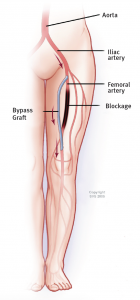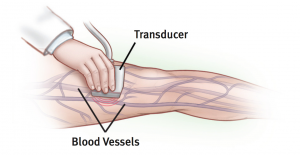
Vascular and Vein Surgery
What is peripheral arterial disease?
Your arteries deliver oxygen-rich blood from your heart to other parts of your body. Your peripheral arteries carry blood away from the heart to your arms and legs. The peripheral arteries in your legs are extensions of the largest artery in your body, the aorta. The aorta travels down through your abdominal region and branches off into the iliac arteries of each leg. The iliac arteries further divide into smaller arteries and deliver blood down your legs to your toes.
Healthy peripheral arteries are smooth and unobstructed, allowing blood to flow freely to the legs and provide oxygen, glucose, and other nutrients that your legs need. Typically with age, the peripheral arteries build up plaque, a sticky substance made up mostly of fat and cholesterol. Plaque narrows the passageway within the arteries and causes them to become stiff. Peripheral arterial disease results when the peripheral arteries become too narrow
or obstructed and limit the blood flow to the legs. If left untreated, peripheral arterial disease can cause pain or aching in the legs, difficulty with walking, resting pain in the foot at night in bed, non-healing sores or infections in the toes or feet, and can lead to limb loss in its most severe form. In addition, it can be associated with other serious arterial conditions leading to heart attacks and stroke.
Causes and risk factors
•Age
•Gender—males are more prone to the condition than females
•Hypertension (high blood pressure)
•Diabetes
•Smoking
•High cholesterol
•Obesity
•Lack of exercise
•Family history of vascular problems
Symptoms
It is important to note that there may be no symptoms in the early stages of peripheral arterial disease. Developing symptoms may include:
- A change in the color of your leg(s)
- Numbness or weakness in your leg(s)
- Sores on your feet, toes or legs that are resistant to healing
- Coldness in skin temperature on your lower leg or foot
- Slower growth of leg hair or slower growth of toenails
- Absence of pulse or no pulse in your feet or leg(s)
- Pain in your calf, thigh or hip muscles after activity (climbing stairs or walking)
Diagnosis
The diagnosis of peripheral arterial disease can be established, and its severity confirmed, by a simple, noninvasive Doppler examination.

When to see a doctor
If you experience symptoms of peripheral arterial disease in your legs, see a vascular surgeon. They are the only physicians treating peripheral vascular disease today who can perform all the treatment options available, including medical management, minimally invasive endovascular angioplasty and stent procedures, and open bypass surgery. Only when you see a vascular surgeon who offers all treatment modalities will you be assured of receiving the care that is most appropriate to your condition.
Even if you don’t have symptoms- screening may be recommended if you are:
- Over age of 70
- Over age of 50 and have been or are a smoker or diabetic
- Under age 50 but have positive risk factors for peripheral artery disease such as high blood pressure, obesity or diabetes
Treatment
Depending on the severity of your condition, treatment options may include lifestyle changes, medications, minimally invasive angioplasty/ stenting, or open bypass surgery.

